📞+86 153 7530 2641 📧 hongjing.Wang@feichuncables.com

Type 440 AS/NZS 2802 Metal-Screened Power Cores Cable with Three Pilot Cores for Mining Trailing & Reeling Applications – Flexible, Abrasion-Resistant Long-Length Cable
Discover the Type 440 AS/NZS 2802 metal-screened power cores cable with three pilot cores—designed for mining trailing and reeling applications. Flexible, abrasion-resistant, and weather-proof for long-length cable runs where Type 409 or 441 pilot resistances fall short.
AS/NZS MINING CABLE
hongjing.Wang@Feichun
8/15/20259 min read
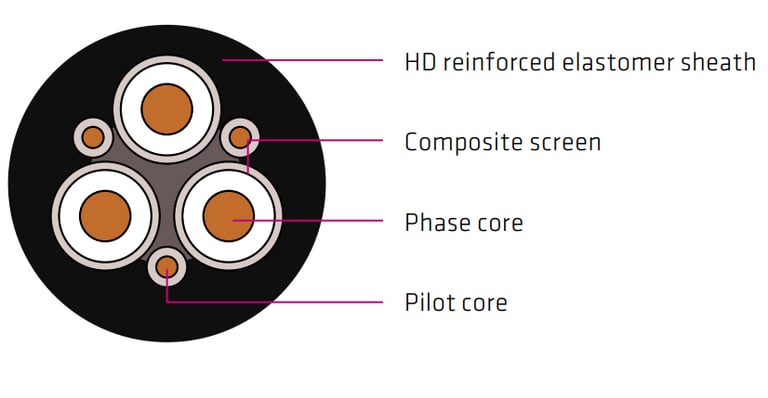

Introduction
The mining industry demands robust electrical infrastructure capable of withstanding the harshest operational conditions whilst maintaining reliable power transmission and control signal integrity. The Type 440 cable represents a sophisticated solution engineered specifically for mining trailing and reeling applications, where conventional cables often fall short of performance requirements. This Class 2 composite screened cable addresses critical challenges in long-length cable runs, particularly where Type 409 or 441 cables may result in pilot resistances that fail to meet operational specifications.
Compliance with AS/NZS 2802 standards ensures that the Type 440 cable meets stringent Australian and New Zealand requirements for mining applications. This standard governs the design, construction, and performance criteria for cables used in hazardous mining environments, establishing benchmarks for safety, durability, and operational reliability. The Type 440's adherence to these standards provides mining operators with confidence in their electrical infrastructure's performance and safety credentials.
The cable's primary applications centre on trailing and reeling operations in both open-cut and underground mining environments. These applications demand exceptional flexibility, superior abrasion resistance, and the ability to maintain electrical integrity across extended cable lengths. The Type 440's innovative design incorporates three pilot cores alongside power conductors, enabling precise control and monitoring capabilities essential for modern mining equipment operation.
Cable Construction & Materials
The Type 440 cable's construction utilises Class 2 composite screened power cores, providing superior electrical performance and enhanced durability compared to conventional cable designs. The power conductors feature tinned copper construction, ensuring excellent conductivity and corrosion resistance in mining environments where moisture and chemical exposure are common concerns. Conductor sizes range from 6 mm² to 300 mm², accommodating various power requirements from auxiliary equipment to heavy-duty mining machinery.
The metal screening system represents a critical component of the cable's design, incorporating a composite screen of tinned annealed copper wire combined with polyester yarn. This dual-material approach provides both electrical screening effectiveness and mechanical reinforcement. The copper wire component ensures proper earthing and electromagnetic interference shielding, whilst the polyester yarn contributes to the cable's flexibility and resistance to mechanical stress during reeling operations.
The three pilot cores constitute a distinctive feature of the Type 440 cable, providing dedicated control and monitoring circuits separate from the main power conductors. These pilot cores are constructed with elastomer covering and proofed tape protection, strategically positioned within the cable's interstices to maximise space efficiency whilst maintaining electrical isolation. Each pilot core maintains its integrity throughout the cable's operational life, ensuring reliable control signal transmission even under demanding mechanical conditions.
Insulation systems vary according to voltage ratings, with polyester conductor tape used for 1.1 kV applications and semiconductive screening employed for 3.3 kV and higher voltage variants. The EPR (R-EP-90) insulation provides excellent electrical properties whilst maintaining flexibility at low temperatures. The heavy-duty HD-85-PCP sheath incorporates polyaramid yarn Kevlar® braid reinforcement, delivering exceptional abrasion resistance and mechanical protection essential for trailing applications.
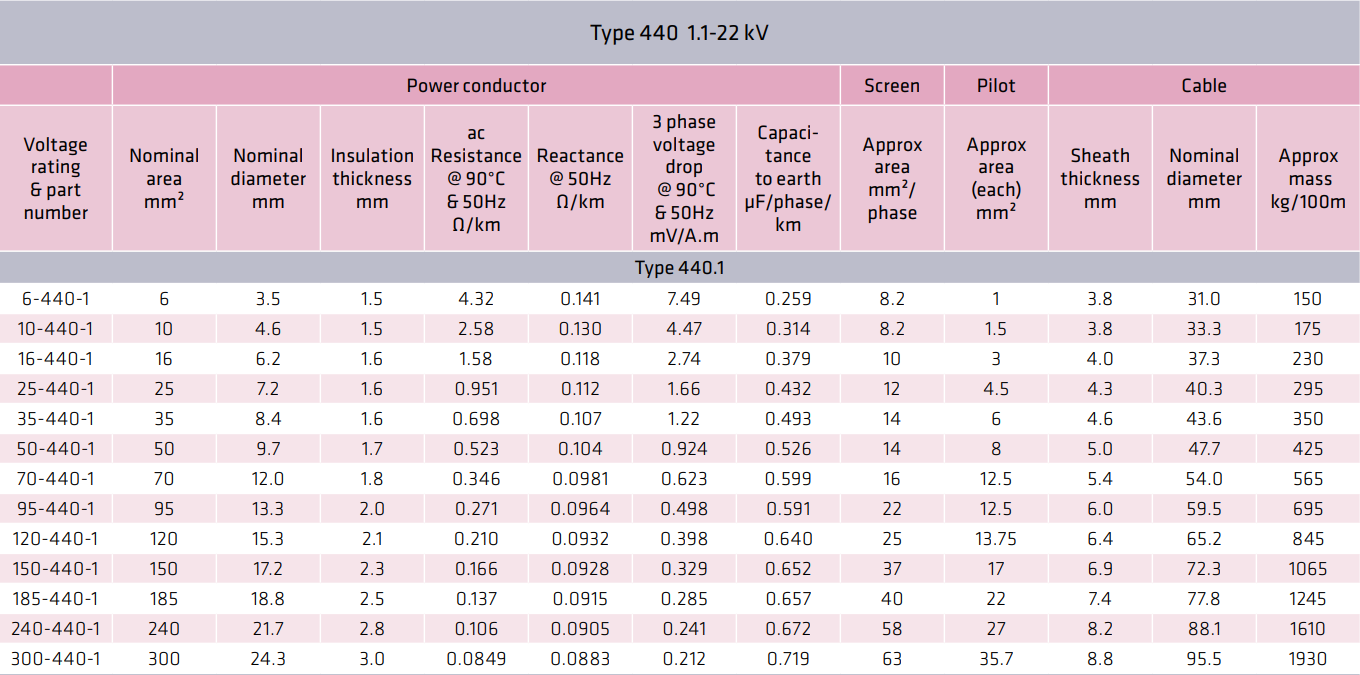


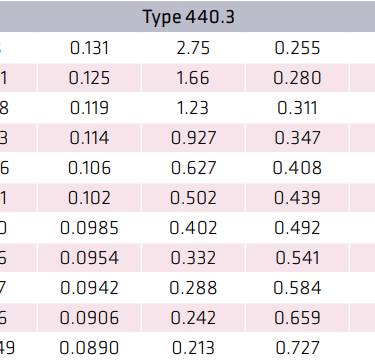

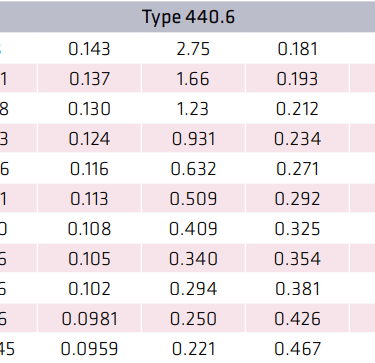

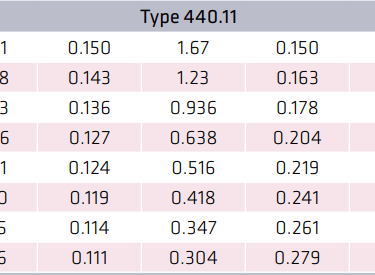

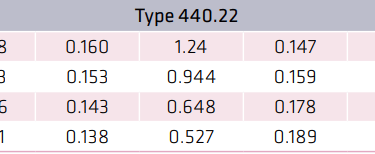
Performance Specifications
The Type 440 cable accommodates a comprehensive voltage rating range from 1.1 kV to 22 kV, with conductor cross-sectional areas spanning from 6 mm² to 300 mm². This extensive range ensures suitability for diverse mining applications, from low-voltage control circuits to high-power transmission requirements. The cable's design optimises electrical performance across all variants, with specific attention to maintaining consistent characteristics regardless of conductor size or voltage rating.
Electrical characteristics demonstrate the cable's superior performance capabilities. AC resistance values at 90°C and 50Hz range from 4.32 Ω/km for 6 mm² conductors to 0.0849 Ω/km for 300 mm² variants, ensuring efficient power transmission with minimal losses. Reactance values remain consistently low across the range, contributing to improved power factor performance. The three-phase voltage drop specifications, calculated at operating temperature and frequency, provide essential data for system designers to ensure adequate voltage regulation across extended cable runs.
Capacitance to earth measurements range from 0.259 μF/phase/km for smaller conductors to 0.727 μF/phase/km for larger variants. These values are critical for determining charging currents and system stability, particularly in long cable installations where capacitive effects become significant. The pilot core specifications ensure adequate cross-sectional area for control signal transmission whilst maintaining compact overall cable dimensions.
Mechanical properties reflect the cable's design for harsh mining environments. The temperature operating range extends from -25°C minimum to +90°C maximum, accommodating extreme climate conditions and varying operational thermal loads. Flexibility ratings ensure the cable maintains adequate bend radius characteristics throughout its operational life, critical for reeling applications where repeated flexing occurs. The cable's construction provides heavy mechanical impact resistance and very good chemical exposure resistance, essential for mining environments where equipment contact and chemical spills are operational realities.


Mining Application Benefits
Trailing applications represent the primary use case for the Type 440 cable, where its design advantages become most apparent. The cable's compatibility with reeling drum systems ensures smooth operation during equipment movement, whilst the three pilot cores maintain accurate resistance values essential for control system functionality. Unlike Type 409 and Type 441 alternatives, the Type 440 cable's pilot core design prevents resistance drift that can compromise control system accuracy in long-length installations.
Long-length cable runs benefit significantly from the Type 440's construction methodology. The composite screening system maintains signal integrity across extended distances, preventing electromagnetic interference from affecting both power transmission and control signals. The cable's low resistance characteristics minimise voltage drop across long runs, ensuring adequate power delivery to equipment regardless of cable length. This capability proves particularly valuable in large open-cut mining operations where equipment may operate considerable distances from power distribution points.
Abrasion and weather resistance capabilities enable the Type 440 cable to withstand harsh underground and surface mining environments. The heavy-duty sheath construction resists cutting and tearing from contact with mining equipment, rock surfaces, and debris. Weather exposure resistance ensures the cable maintains its properties during surface storage and installation, whilst the fire-retardant characteristics provide essential safety margins in underground applications where fire risk management is critical.
When compared with Type 409 and Type 441 cables, the Type 440 demonstrates superior pilot resistance performance and control signal reliability. The dedicated pilot core design eliminates the resistance variation issues that can affect other cable types, particularly in long-length applications. This performance advantage translates to improved control system accuracy, reduced maintenance requirements, and enhanced operational reliability in critical mining applications.
Installation & Maintenance Guidelines
Proper handling and laying procedures for long continuous runs require careful planning and execution to preserve the cable's performance characteristics. Installation teams should utilise appropriate cable pulling equipment and maintain recommended bend radius limits throughout the installation process. The cable's flexibility characteristics facilitate installation in confined spaces, but care must be taken to avoid excessive stress concentrations that could compromise the screening integrity or conductor alignment.
Reeling operation best practices centre on proper reel selection and drum design compatibility. The cable's construction accommodates repeated reeling cycles, but drum diameter selection must consider the minimum bend radius requirements to prevent mechanical stress damage. Regular inspection of reel mechanisms ensures smooth cable deployment and retrieval, whilst proper tensioning prevents excessive stress during operation. Storage reels should protect the cable from environmental exposure and mechanical damage during non-operational periods.
Routine inspection protocols focus on screening integrity and pilot core continuity testing. Visual inspection procedures identify potential abrasion damage, cut hazards, or environmental degradation before these issues compromise operational safety or performance. Electrical testing of pilot core continuity ensures control system reliability, whilst power conductor testing verifies ongoing electrical performance. Regular inspection schedules should reflect operational intensity and environmental exposure conditions.
Repair techniques for cuts, abrasion damage, and end termination require specialised knowledge and appropriate materials to maintain the cable's performance characteristics. Field repair procedures should preserve screening effectiveness and pilot core integrity whilst restoring mechanical protection. End termination techniques must accommodate the cable's construction complexity, ensuring proper separation and protection of power conductors, screening systems, and pilot cores. Professional installation and repair services ensure compliance with AS/NZS 2802 requirements and maintain warranty coverage.


Safety & Compliance
AS/NZS 2802 regulatory requirements establish comprehensive testing protocols and performance standards for mining cable applications. These requirements encompass electrical performance verification, mechanical property testing, environmental resistance evaluation, and fire safety characteristics. Compliance testing ensures the Type 440 cable meets all applicable safety standards whilst providing documented evidence of performance capabilities essential for mining operation approvals and insurance requirements.
Fire retardancy testing standards verify the cable's ability to resist flame propagation and limit fire spread in mining environments. The cable's fire-retardant construction meets specified testing criteria, providing essential safety margins in underground applications where fire prevention and control are critical safety considerations. Cable marking systems provide clear identification of fire performance characteristics, enabling proper selection for specific installation requirements.
Environmental and operator safety considerations encompass both the cable's resistance to environmental degradation and its contribution to overall mining operation safety. The cable's chemical resistance prevents degradation from exposure to mining chemicals, whilst its abrasion resistance reduces the risk of conductor exposure that could create electrical hazards. Proper earthing through the screening system ensures electrical safety for personnel and equipment in mining environments where earth fault protection is essential.
Common Cable Issues and Solutions
Q: What causes pilot core resistance drift in long cable runs, and how does the Type 440 prevent this issue?
A: Pilot core resistance drift typically results from temperature variations, mechanical stress, and conductor movement within the cable structure. The Type 440 cable addresses this through its elastomer-covered pilot cores with proofed tape protection, strategically positioned within cable interstices. This design maintains stable conductor geometry and provides superior temperature stability compared to conventional pilot core arrangements found in Type 409 and Type 441 cables.
Q: How does the composite screening system maintain electromagnetic compatibility in high-interference mining environments?
A: The Type 440's composite screen combines tinned annealed copper wire with polyester yarn, creating both an effective electromagnetic shield and mechanical reinforcement. The copper wire component provides low-impedance earthing paths and electromagnetic screening effectiveness, whilst the polyester yarn maintains screen integrity under mechanical stress. This dual-material approach ensures consistent screening performance throughout the cable's operational life, even under severe mechanical conditions.
Q: What maintenance indicators should operators monitor to prevent cable failure in trailing applications?
A: Key maintenance indicators include visual inspection for abrasion damage, regular pilot core continuity testing, power conductor insulation resistance measurements, and screening system integrity verification. Operators should monitor cable temperature during operation, inspect connection points for signs of overheating, and check reel mechanisms for proper alignment and tensioning. Establishing routine inspection schedules based on operational intensity helps identify potential issues before they compromise system reliability.
Q: How should the Type 440 cable be stored and handled to preserve its performance characteristics?
A: Proper storage requires protecting the cable from direct sunlight, extreme temperatures, and mechanical damage. Cable reels should be stored on level surfaces with adequate support to prevent deformation. During handling, maintain recommended bend radius limits and use appropriate lifting equipment for heavy cable sections. Avoid dragging the cable across rough surfaces and protect end terminations from moisture ingress during storage periods.
Conclusion
The Type 440 AS/NZS 2802 metal-screened power cores cable with three pilot cores represents a significant advancement in mining cable technology, specifically engineered to address the demanding requirements of trailing and reeling applications. Its superior construction methodology, incorporating composite screening systems and dedicated pilot cores, delivers performance advantages that directly translate to improved operational reliability and reduced maintenance requirements in mining environments.
The cable's comprehensive voltage range from 1.1 kV to 22 kV, combined with conductor sizes spanning 6 mm² to 300 mm², ensures suitability for diverse mining applications whilst maintaining consistent performance characteristics. The flexible long-length mining cable design accommodates the dynamic requirements of modern mining operations, where equipment mobility and extended cable runs are essential operational parameters.
For mining operators seeking reliable electrical infrastructure capable of withstanding harsh environmental conditions whilst maintaining precise control system functionality, the Type 440 cable provides a proven solution. Its AS/NZS 2802 compliance ensures regulatory adherence, whilst its superior pilot resistance performance addresses the limitations commonly encountered with alternative cable types in long-length applications.
Technical support and procurement information for Type 440 cables is available through authorised distributors and cable manufacturers specialising in mining applications. Proper specification review ensures optimal cable selection for specific operational requirements, whilst professional installation services guarantee compliance with applicable standards and warranty coverage.
How to Reach Us
Get in Touch
SiteMap
Product Catalogue
Reeling Cable
Festoon Cable
Shore Power Cable




Scan to add us on WeChat
